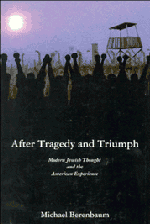Book contents
- Frontmatter
- Contents
- Foreword
- Introduction
- PART I THE HOLOCAUST IN CONTEMPORARY AMERICAN CULTURE
- 1 The Nativization of the Holocaust
- 2 The Uniqueness and Universality of the Holocaust
- 3 Public Commemoration of the Holocaust
- 4 Is the Centrality of the Holocaust Overemphasized? Two Dialogues
- 5 Issues in Teaching the Holocaust
- 6 What We Should Teach Our Children
- 7 The Shadows of the Holocaust
- PART II JEWISH THOUGHT AND MODERN HISTORY
- Notes
- Index
3 - Public Commemoration of the Holocaust
Published online by Cambridge University Press: 06 January 2010
- Frontmatter
- Contents
- Foreword
- Introduction
- PART I THE HOLOCAUST IN CONTEMPORARY AMERICAN CULTURE
- 1 The Nativization of the Holocaust
- 2 The Uniqueness and Universality of the Holocaust
- 3 Public Commemoration of the Holocaust
- 4 Is the Centrality of the Holocaust Overemphasized? Two Dialogues
- 5 Issues in Teaching the Holocaust
- 6 What We Should Teach Our Children
- 7 The Shadows of the Holocaust
- PART II JEWISH THOUGHT AND MODERN HISTORY
- Notes
- Index
Summary
Scores of works present liturgies of Holocaust commemoration, but few have examined the ceremonies critically. This chapter is the first analysis of state-sponsored Holocaust commemorations initiated in America. Among the problems considered here is the ambivalence felt by survivors of the Holocaust, along with the rest of American Jewry, who seek a national imprimatur for their day of mourning yet fear dilution and dejudaization once commemoration leaves the confines of communal observance.
For two hundred years, the modern Jew faced two choices: self-imposed ghettoization, or the strict separation of Jewish life from the public domain. Our generation has the opportunity to reverse the rules of postemancipation Jewish life; Jewish communal engagement in politics and public life (manifested in events such as civic commemorations of the Holocaust) should be welcomed.
There are three separate but intersecting histories of the Holocaust that bear commemoration: those of the perpetrators, the bystanders, and the victims. American Jews can claim two of these histories as heirs of the victims and fellow countrymen (or descendants) of the bystanders. Israeli Jews relate most basically to the history of the victims, yet they have felt uncomfortable with some aspects of that identification because of a national posture of military strength. Israelis also participate in the bystanders' legacy because the Yishuv (the prestate Jewish community in Palestine) was relatively inactive during the late 1930s and early 1940s.
Christianity must accept two histories. Self-proclaimed Christians not only were bystanders but were among the perpetrators, and the choice of Jews as victims stemmed either directly or indirectly from the church's treatment of Judaism in its liturgy and theology.
- Type
- Chapter
- Information
- After Tragedy and TriumphEssays in Modern Jewish Thought and the American Experience, pp. 33 - 42Publisher: Cambridge University PressPrint publication year: 1990

